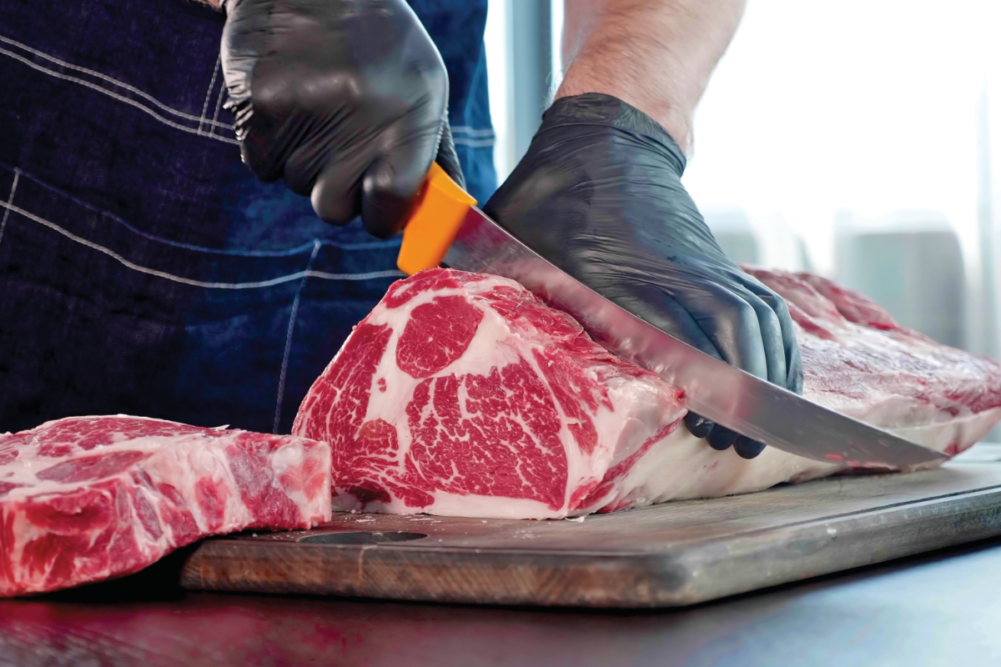COLLEGE STATION, TEXAS — For those in the beef industry, the fact that beef is larger and heavier than it was in the past is not breaking news. Cattle are heavier, making carcasses weigh more. Subprimals are larger and heavier, making retail cuts larger. This trend began about 40 years ago, and we do not know where it will end. However, we do know that developing effective merchandising strategies to help retail and foodservice channels deal with how best to market beef is imperative to all of the stakeholders in the supply chain.
Although the exact starting point for when the move to heavier cattle and carcasses began is unknown, it is clear that by the mid-1970s, there was a slow and gradual increase. It is interesting that this is the same point where the greatest amount of beef, at least on a per-capita basis, was being produced. Whether these two items are related is not fully understood. A slow decline in cattle inventory began, and the sheer amount of beef produced would be much lower today if it had not been for the fact that heavier weights helped offset fewer cattle.
In the days before the advent of boxed beef, carcasses, forequarters and hindquarters were shipped first by refrigerated rail cars and then by refrigerated trucks to markets where beef was cut into wholesale and retail cuts. There were preferences for certain weights, grades and types of beef depending on what customers wanted. All beef found a home regardless of its shape and size, but market prices were impacted if too many or too little of certain types were produced. From a weight standpoint, major purchasers of beef had a range in carcass weights they would accept.
Few innovations in the beef industry have impacted where and what form beef is processed than what boxed beef did. The early adopters of boxed beef became today’s major beef companies, and what began in earnest in the 1960s definitely changed how beef is marketed today.
The pioneers of boxed beef simply cut carcasses into wholesale cuts. IBPs 7-box style CattlePak had boxes for each round, loin and chuck with one box for both ribs. This began the shift from distribution in the carcass form to vacuum-packaged box beef. While this style of marketing began with boxing beef, the next versions of cutting beef based on weight became more evident.
With boxed beef, the opportunity to purchase subprimals rather than primals allowed retail and foodservice segments to specialize in the type of beef they utilized rather than having to find a home for a wider variety of beef cuts. Additionally, beef packers began expanding the array of products offered to their customers. Fabrication rooms became larger and more complex, and the types of beef being fabricated changed.
During the 1980s, packers often sorted carcasses by weights. The lighter carcasses, usually 600 to 750 lbs., would be used to produce bone-in products, and the heavy carcasses, usually 750 to 900 lbs., would be used to produce boneless products. Moving to more boneless beef was one way to battle heavier weights of cuts while ensuring that box weights remained reasonable, at least initially.
The retail sector likely played an important role in the next evolutionary steps of boxed beef. Traditional cuts of arm, blade, and 7-bone steaks and roasts no longer appealed to consumers because of their sizes and price points. Changes in fabrication paved the way for innovation and increased demands for shoulder clods, chuck rolls, inside rounds, bottom rounds and eye of rounds. The old-school cuts can still be found in some ethnic markets and custom locker orders, but the retail beef case of today looks so much different than it did decades ago. The move to even more subprimal products has allowed for or maybe even encouraged the increase in beef carcass sizes and weights. A visit to any of the major beef plants today reveals complex layouts of boning, trimming and packaging lines where carcasses are broken into more products than ever.
The National Cattlemen’s Beef Association created new cutting styles focused on the ribeye, strip loin and top sirloin butt. These Beef Alterative Merchandising styles feature combinations of marketing individual muscles with some of them actually split in half for the loin end of the ribeye or for the entire strip loin or cut into many more pieces for the top sirloin butt. Some of the challenges associated with merchandising beef this way are the increased labor required to transform these subprimals into retail cuts and the potential for additional yield loss. Ultimately, retail prices must cover these issues, therefore, demand will have to remain high enough for new and innovative cuts to become commonplace.
While individuals in our generation may mourn the loss of the cuts we grew up with such as the 7-bone steak, round steak and arm roasts, the next potential cut on the endangered list is the T-bone/Porterhouse steak. This iconic beef cut may suffer the same fate as traditional chuck and round cuts because of its massive size, weight and cost. Today’s beef is merchandised much differently than yesterday’s beef, and innovation in cuts and consumer demand will continue to influence the types of cuts found in retail markets.

